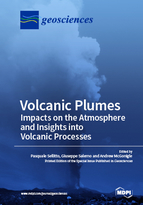Volcanic Plumes: Impacts on the Atmosphere and Insights into Volcanic Processes
A special issue of Geosciences (ISSN 2076-3263). This special issue belongs to the section "Natural Hazards".
Deadline for manuscript submissions: closed (15 November 2017) | Viewed by 85412
Special Issue Editors
Interests: atmospheric aerosols; air pollution; climate; atmospheric radiative transfer; cirrus clouds; upper troposphere-lower stratosphere; pollution-climate interactions; Asian monsoon; volcanic emissions; remote sensing
Special Issues, Collections and Topics in MDPI journals
Interests: volcanology; eruptive mechanism and dynamics; remote observation of magmatic degassing
Special Issues, Collections and Topics in MDPI journals
Special Issue Information
Dear Colleagues,
Volcanoes release plumes of gas and ash to the atmosphere, during episodes of passive and explosive behaviour. These ejecta have important implications for the chemistry and composition of the troposphere and stratosphere, with the capacity to alter Earth's radiation budget and climate system over a range of temporal and spatial scales. In particular, volcanogenic sulphur dioxide reacts to form sulphate aerosols, which increase global albedo, e.g., reducing surface temperatures, in addition to perturbing the formation processes and micro-physics, and therefore the optical/radiative properties, of low and high clouds. In addition, the diabatic radiative processes due to volcanic aerosols and subsequently formed clouds can alter the vertical stability and motion of the atmosphere. Released halogen species can also alter the oxidation capacity of the troposphere, and explosive eruptions cause the depletion of stratospheric ozone. Volcanic degassing, furthermore, played a key role in the formation of Earth’s atmosphere and volcanic plumes can degrade local and regional air quality, generate acid rain, pose hazards to aviation and human health, as well as damaging ecosystems. The chemical compositions and emission rates of volcanic plumes are also monitored, via a range of direct sampling and remote sensing instrumentation, in order to gain insights into subterranean processes, in respect of the magmatic bodies these volatiles exsolve from. Given the significant role these gases play in driving activity, e.g., via pressurisation, this is proving to be an increasingly fruitful means of improving our understanding of volcanic systems, potentially in concert with observations from geophysics and contributions from fluid dynamical modelling of conduit dynamics.
This Special Issue is aimed at presenting state of the art, multi-disciplinary science concerning all aspects of volcanic plumes, of relevance to the volcanology, climatology and atmospheric science communities.
Authors are encouraged to submit articles with respect to the following topics:
- Novel and improved techniques for direct and remote (including satellite based) observations of gas and aerosols in volcanic plumes;
- Use of volcanic degassing data to improve our understanding of volcanic and hydrothermal processes;
- Satellite-based techniques and modelling studies which improve constraints upon the location and spatio-temporal dispersion of volcanic plumes;
- Chemical processes occurring within volcanic plumes and plume impacts upon atmospheric composition, aerosol and cloud parameters;
- Impact of volcanic emissions on local and regional air quality;
- Direct (aerosol-radiation interactions) and indirect (aerosol-cloud-radiation interaction) climatic impacts of volcanic plumes over a range of spatio-temporal scales;
- Dynamical, chemical and micro-physical modelling tools and their application to refine and better describe the temporal and spatial evolution of volcanic plumes.
We invite you to submit your manuscripts. Both research articles and reviews will be considered for publication.
Dr. Pasquale Sellitto
Dr. Giuseppe Salerno
Dr. Andrew McGonigle
Guest Editors
Manuscript Submission Information
Manuscripts should be submitted online at www.mdpi.com by registering and logging in to this website. Once you are registered, click here to go to the submission form. Manuscripts can be submitted until the deadline. All submissions that pass pre-check are peer-reviewed. Accepted papers will be published continuously in the journal (as soon as accepted) and will be listed together on the special issue website. Research articles, review articles as well as short communications are invited. For planned papers, a title and short abstract (about 100 words) can be sent to the Editorial Office for announcement on this website.
Submitted manuscripts should not have been published previously, nor be under consideration for publication elsewhere (except conference proceedings papers). All manuscripts are thoroughly refereed through a single-blind peer-review process. A guide for authors and other relevant information for submission of manuscripts is available on the Instructions for Authors page. Geosciences is an international peer-reviewed open access monthly journal published by MDPI.
Please visit the Instructions for Authors page before submitting a manuscript. The Article Processing Charge (APC) for publication in this open access journal is 1800 CHF (Swiss Francs). Submitted papers should be well formatted and use good English. Authors may use MDPI's English editing service prior to publication or during author revisions.
Keywords
- Volcanic plume observation and modelling
- Volcanic degassing and aerosol
- Atmospheric impact of volcanic eruption
- Volcanoes/Climate interactions
- Eruptive processes
- Volcanic degassing dynamics
- In-plume chemical processes
- Plume dispersion








